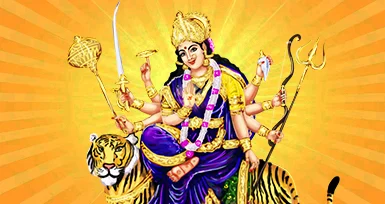Navaratri Goddesses, Significance, Colors & More
Navaratri is a joyous time for celebration, awakening, and devotion. Celebrate the occasion with faith and commitment to receive the gifts of joy, prosperity, and divine favor in your life.
Navaratri Goddesses, Significance, Colors & More
Shardiya Navaratri, also known as Navaratri, is one of the most important festivals celebrated in India dedicated to Goddess Durga and her nine Shakti forms. Celebrated for nine days, the festival symbolizes the battle between good and evil, culminating in a victory on the tenth day. It is a period when Goddess Durga is worshipped, and it is a time for great devotion, wisdom, power, energy, and fasting. Read below to know about Navaratri Goddess Durga, her nine forms, and significance, colors and more.
Significance of Navaratri
Navratri is a celebration of the divine feminine power that protects and nurtures the universe from evil, showcasing that good always prevails over evil. During Navratri, Shakti is worshipped in her 3 forms of Lakshmi, Saraswati and Durga and their unique 9 Avatars.
The 9 forms are as follows:
● Shaiaputri, the daughter of mountains
● Brahmacharnini, the female celibate
● Chandraghanta, the deity with a half-moon shape like a bell
● Kushmanda, the cosmic egg creator
● Skandamata, the mother of Skanda
● Katyayani, the daughter of Katyayana
● Kalaratri, terrible night
● Mahagauri, extreme white
● Siddhidatri, the giver of supernatural powers
Worshipping these forms of Goddesses in those nine nights may bestow knowledge, prosperity and abundance.
Navaratri, 2025 Festivals and Dates
Navaratri is a festival and a culture rooted in the awareness of the human system’s relationship to the Sun, Moon, Earth, and other elements of the divine. Navaratri means “nine nights” and begins after Amavasya (new moon). The first day of this lunar cycle, until the ninth day, called Navami, is considered feminine energy as it represents Devi (a divine feminine aspect). Traditionally, the first upto nine days of this phase are dedicated to the feminine energy.
While there are 12 nine-day periods every year, with a focus on a different feminine divine aspect, the Navaratri that falls in October is the most significant. This is dedicated to the goddess of learning, Sharada. Here is the list of nine nights, their significance and the color to wear.
Day 1: Monday, September 22nd, Devi Shailputri festival and Ghatasthapana on Pratipada tithi. This is the first day of Navaratri, during which the Goddess Shailputri, a form of Goddess Parvati, the daughter of the Mountain God, is worshipped.
White: It is a symbol of harmony and peace. Wearing a white costume on this day helps you with purity, happiness and security.
Day 2: Tuesday, September 23rd, the festival of Devi Brahmacharini Pooja on Dwitiya tithi. Brahmacharini is a form of Durga. Goddess Brahmacharini is worshipped on this day, who symbolises the moderation of anger.

Red: It is worn on this day as it is a color that signifies bravery, passion and love. Wearing this colour helps women be blessed with beauty, vitality and loyalty for the rest of the year. It also helps defeat distress, sins and other negative effects in their lives.
Day 3: Wednesday, September 24th, Devi Chandraghanta Pooja festival on Tritiya tithi. Devi Chandraghanta is one of the forms of Shakti, and she is depicted as having a third eye, battling the demons. Jasmine flowers are presented to her at the time of Pooja to appease her.
Royal Blue: It signifies royalty and elegance. Wearing this color brings a passion to excel and a charisma in life.
Day 4: Thursday, September 25th, festival of Devi Kushmanda Pooja on Chaturthi tithi. Kushmanda translates as "cosmic egg", and it is a worship day for the Goddess Kushmanda, who is believed to diffuse warmth and energy to all.
Yellow: Devotees wear this color as it is believed to bring positivity and happiness to life. It signifies joy and warmth, and the wearer feels cheerful and calm all through the year.
Day 5: Friday and Saturday, September 26-27, the festival of Devi Skandamata Pooja on Panchami tithi. This day is devoted to the ruler of Budha (planet Mercury), Goddess Skandamata. She is worshipped for her fierce but loving nature.
Green: It is the color that represents peace, serenity, growth, and fertility. Donning green attire provides you with serenity and blesses you with the Goddess's grace.
Day 6: Saturday, September 27th, the festival of Devi Katyayani Pooja on Maha Shashti tithi. On this day, it is said that Goddess Durga took the form of Katyayani to kill Mahishasura, the king of demons. Women pray to her on this day for a peaceful family life.
Grey: It's the color to be dressed in on day 3. It signifies a balance of emotions, and being an earthy color, it symbolizes humility and no-nonsense conduct.
Day 7: Sunday, September 28th, the festival Devi Kalaratri Pooja, on Maha Saptami tithi. This festival is dedicated to Kalaratri, who is said to have a fierce nature and terrify evil spirits. She is the ruler of Lord Shani (Saturn) and is one of Mother Kali’s most destructive forms.
Orange: It is a color that infuses positive energy, creativity and joy. Wearing this color helps you approach life problems with positive feelings and a calm mind.
Day 8: Monday and Tuesday, September 29, 30, the festival of Devi Mahagauri Pooja and Maha Ashtami tithi. It is referred to as Maha Durgashtami or Mahastami. A unique function, Kanya Pooja, is celebrated for young girls on this day. Prayer, dance, and fun-filled functions are held on this day.
Peacock green: It represents intelligence, individuality and evokes compassion, peace and uniqueness.
Day 9: Tuesday and Wednesday, September 30, October 1, the festival of Devi Siddhidatri Pooja on Maha Navami tithi. It is said that Devi Siddhidaatri is a giver of all wishes, and hence the ninth day is devoted to her.
Pink: It symbolises goodness, harmony and affection. The color is stated to make the wearer charming and human, loved by all.
Day 10 & 11: Wednesday and Thursday, October 1, October 2, the festival of Dashami and Dussehra on the Dasami tithi. After nine days of worshipping various forms of Durga Devi, the tenth day is a day for the celebration of victory over evil. It is also referred to as Vidyarambham, a good time for new activities, particularly initiating toddlers into learning.
Conclusion
Navaratri is a joyous time for celebration, awakening, and devotion. Celebrate the occasion with faith and commitment to receive the gifts of joy, prosperity, and divine favor in your life.







